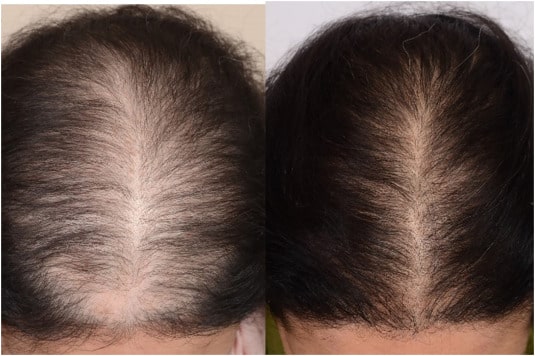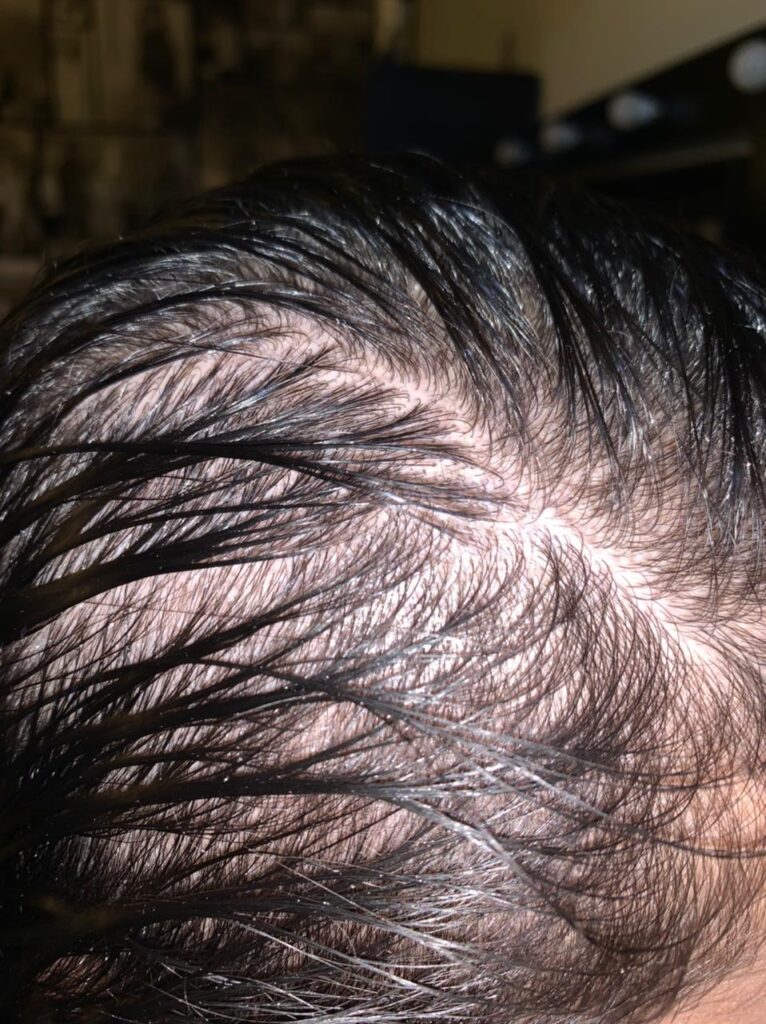Female hair fall treatment in Lahore Pakistan by Renowned hair specialist. Thinning of hair is one of the most common problems of both genders. Men may be suffering from it because of genes and inheritance, but women most commonly suffer from hair fall or hair thinning for a variety of reasons such as, hormonal changes, aging, and genetics, etc. Apart from all of these causes, infections, excessive hair beauty treatments, unnecessary hair pulling, alopecia areata, autoimmune disorders, thyroid problems, ovarian tumors, adrenal gland tumors, and burns etc. may also be one of the many reasons for hairline thinning. However, doctors may suggest that the real reason for hair fall or hair thinning is unknown and we all can play guess games as long as we want. The causes may be vague and unknown, but the treatments are in the hands of skilled doctor. According to some statistics, women spend two and a half years of their average life span on maintaining and making their hair look good. This shows how important these hair are for them. But if hair starts to cause any problem, such as hairline thinning or fall, depression can easily be seen. This depression can do nothing else than increase the problem. Yes, long gone days when you had to cope up with the high forehead, or hairline thinning. Being a female, this problem had caused many ladies to feel ashamed, unwanted and embarrassed. If you or anyone you love is among such women, say a big thanks to science. Doctors have come up with such amazing technologies to take you away from these problems that you will love yourself soon. Female hair fall treatment in Lahore Pakistan at our clinic has been performed successfully for the last many years.
Most effective female hair fall treatment Lahore Pakistan
Androgenic alopecia (also known as Female Pattern Hair Loss) is FPHL which leads to hair thinning, affecting women most prevalently. Finer and softer hair can happen because of the reduction in phases of hair growth with time, which leads to shrinking follicles. It can profoundly impact a woman’s emotional health.
What treatments work best for Female Hair Loss?
1. Minoxidil (Topical Treatment)
background: Minoxidil is a medication in general used for promoting hair boom and treating male baldness by using stimulating hair follicles.
Efficacy: Studies revealed that women treated with minoxidil had a significantly higher hair regrowth compared to those on a placebo. Specifically, there was an important increase in total hair count per cm².
Concentration Comparison: The research showed no significant differentiations in efficacy between the 2% and 5% minoxidil solutions.
Safety: Dermatitis, skin irritation, and unwelcomed hair growth were some of the adverse effects recorded; itchiness was also a problem area. Although no notable difference in adverse events was found between minoxidil and a placebo.
2. Finasteride (Oral Medication)
Background: Though primarily approved for men to treat hair loss and enlarged prostate, some studies have explored its effects on women.
Efficacy: Results were mixed, with one small study indicating a benefit while others showed no more efficacy than placebo.
Safety: Adverse events were comparable between finasteride and placebo groups in the one study that addressed this.
3. Low-Level Laser Therapy (LLLT)
Background: LLLT involves the use of red and near-infrared light to stimulate hair growth.
Efficacy: Two studies indicated that while participants did not perceive a difference between LLLT and a sham device, there was an objective increase in hair growth in the LLLT group.
Safety: Adverse events were not distinctively reported, making the safety profile unclear.
4. Hair Transplant Surgery
A surgical procedure where hair follicles from one part of the body are moved to balding or thinning areas.
Efficacy: Hair transplants can offer permanent solutions to hair loss, but the success rate and appearance can vary.
Safety: As with any surgery, there’s a risk of complications, such as infections and scars.
5. Platelet-Rich Plasma (PRP)
PRP involves drawing a patient’s blood, processing it, and then injecting it into the scalp to stimulate hair growth.
Efficacy: Some studies suggest that PRP can help increase hair thickness and density.
Safety: Risks can include infection, injury to blood vessels or nerves, and calcification at the injection points.
Other Treatment Options
1. Spironolactone: An oral medication often used to treat high blood pressure, but has been found to have anti-androgen effects which might help in FPHL.
2. Cyproterone Acetate: As a primary beginning control approach, it also effectively treats hirsutism and androgenic alopecia in ladies..
3. Hair Wigs and Extensions: Not a treatment, but they can be useful for covering areas of hair loss and giving a fuller appearance to hair.
4. Dutasteride: Unlike finasteride but targeting two kinds of 5-alpha-reductase enzymes, this oral medication could yield improved defense against hair loss.
5. Hair Scalp Micropigmentation: A tattoo technique to create the illusion of denser hair.
Main Findings
Out of 47 studies covering 5290 participants, only five were identified as ‘low risk of bias’. The majority of these studies were unclear or at high risk. Minoxidil, tested in 17 studies, was found to be effective. It showed a significant increase in hair regrowth and density when compared to a placebo. However, no major difference was identified between 2% and 5% minoxidil concentrations.
Finasteride, every other drug tested, did not display a fantastic improvement over a placebo. On the other hand, low-level laser comb remedy demonstrated some advantages in hair rely, but individuals didn’t recognize it as greater than a sham device. Other interventions were part of individual studies, with most providing limited evidence about their efficacy and safety.
Research Conclusion
Minoxidil has proven to be an effective and safe treatment for FPHL, though there is no discernible difference between the 2% and 5% concentrations. Finasteride did not outperform placebo. Laser devices showcased mixed results. More studies are needed to assess other treatments like spironolactone, different dosages of finasteride, dutasteride, and laser therapies. The predominant form of hair thinning in women is FPHL. This hair loss begins post-puberty and becomes more prevalent after menopause. Diagnosis requires a thorough understanding of the patient’s history and sometimes clinical tests. FPHL can severely dent a woman’s self- confidence, causing emotional stress.
The study overviewed the latest data up to July 2015, analyzing 47 studies with 5290 female participants. Findings showed minoxidil as an effective treatment, but no clear advantage was seen between 2% and 5% concentrations. Finasteride didn’t show better results than a placebo, and laser comb therapy had inconclusive outcomes.
Overall, more research is needed to provide conclusive evidence on various treatments’ efficiency and safety.
Conclusion
While there are multiple treatments available for FPHL, their effectiveness can vary from person to person. It’s crucial for individuals to consult with a dermatologist or hair loss specialist to find the most appropriate treatment based on their specific condition and needs.
Hairline thinning treatment Lahore Pakistan
We understand that hairline thinning in females can be the most embarrassing thing, for which we have come up with the best solution, hairline transplant. Yes, it is possible now and has been saving many lives for years. There are a few treatments to solve this problem, but hairline transplant is the most appreciated and encouraged method. FUE method of hair restoration is adopted to treat hairline. The method is popular because it can almost reverse the years and can make the lady look young and beautiful once again. The method not only promises to give natural results, but because of highly advanced technologies and other advancement, it has never let the patient down as the best choice for hairline treatment.
Procedure details:-
Before the treatment
Before the treatment starts, Dr. Ahmad Chaudhry will take a detailed look at the patient’s hair and especially the hairline. This will give him a detailed view of the problem, its intensity, the quality of work needed and the possible results the patient wants.
During the treatment
Dr. Ahmad Chaudhry will use his excellent skills and capabilities and will extract the healthy hair follicles from the donor site and will place one by one or implant them on the recipient site. This process needs extreme caution excellence and perfect grip over incisions. The FUE method is known for natural looking results, but when we are talking about hairline transplant, know that even small scars are visible in this region.
After the surgery
This method is a walk in, walk out method. This means that no long stays in the hospital and no lengthy post-operative treatments are needed. After getting treated for a few hours, the patient would be allowed to indulge in her regular routine easily.
Benefits of FUE hairline transplant
- Ideal method of transplant as no or zero visibility of scars production
- Donor area remains unchanged
- Natural and fuller results are guaranteed
- No scalpel, no stitches
- Speedy recovery
- Only healthy donor hair follicles are used
- Simpler and less painful method
Risks related in this process
Some of the risks involved in this hairline transplant are:
Not getting natural or desired results, this happens when you choose any unskilled or inexperienced doctor.
Infection
Poor hair growth
Bleeding
Persistent numbness from nerve damage, etc.
Results of hairline hair restoration
No matter what treatment you go through for getting a good, natural and fuller hairline, the aim of all treatments would be the same, to restore maximum areas of depleted hair. Certain medications when used after the surgery can maximize the positivity of results, however, remember the fact that the hair follicles which are lost completely cannot regrow through any method. Doctors all over the globe believe that transplant is the only and the most reliable method which is present in this modern age. The doctors will check and do a detailed analysis of your hairline condition and will only suggest this method if the results are predictable to be positive and will be beneficial for you. The only limitation of getting hair back was that lost follicles cannot be re grown, this limit remains firm, but FUE can place healthy follicles in that place providing adequate follicles to the recipient area to grow well.
Are you a candidate for female hair loss treatment in Lahore Pakistan
Anyone can be a potential hairline transplant patient who wishes to look good with a fuller and natural hairline. But doctors suggest that if you do not have this hair fall or hairline thinning problem in genes, you should opt this treatment. Otherwise, wasting your time and money would be needless as in a few years’ time, you will be losing your hair anyway. Furthermore, younger ladies would be simply wasting their energies and money on this treatment as they too will lose their hair soon as they age. Instead, young ladies must choose any other method like medicines or therapy or even home remedies to get rid of this. If you are not in the categories discussed, visit the best hair specialist doctor in Lahore– Dr. Ahmad Chaudhry and get your hair and scalp examined. The doctor would suggest you about the treatment to go for.
FUT treatment is also used to lower the hairline, but because of the scars and stitches, people prefer the latest FUE technique for hair restoration. Let your new hair grow, just choose the best doctor for hair loss in Lahore wisely.
Where to contact for female hair thinning?
You may write, call or WhatsApp +92-333-430-9999
People also search
| Female hair transplant | 2647 grafts before after photos |
| Stem cell hair treatment | PRP treatment for hair growth |
Free consultation | Write us or WhatsApp | +923334309999



